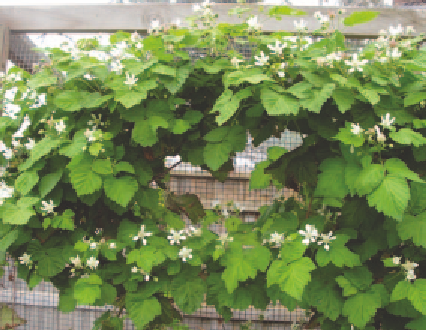Agriculture Reference
In-Depth Information
cutting out any weak or damaged canes
through the growing season leaving 15 cm
between canes.
As the primocanes grow, tie them to the
trellis and twist them around the top wire if
they grow taller. Primocanes can have
their tips removed to stop them flapping
about in the wind, but the longer the cane,
the more fruit will be produced and they are
easily secured by winding them around the
trellis's wire.
As always, remove dead, damaged or diseased
wood as soon as you see it.
Figure 11.4
The cultivated and semi-tame blackberries
and their hybrids are best trained well above the ground.
Bramble berries can be trained to a trellis by bundling a
few canes together and winding them around the wires.
Harvest
Raspberries ripen over a period of four to five
weeks for each cultivar so pick your berries
daily. Gently squeeze the berry and pull to
detach it from its stem.
Plant out the berries in winter and cut them
back to two to three buds to prevent fruiting
and to get them established the first year.
Once the new canes grow from the base there
are several ways to attach the canes to the
trellis. They can be fan trained with 25 cm
between the canes, bundled two to three
canes together and wound around the wire
(Figure 11.4), or woven through the wires
(see Figure 11.5).
Brambleberries
Rubus
spp.andhybrids
Bramble berries include the more civilised
members of the blackberry clan. They are easy
to manage especially the thornless cultivars.
The cultivated and semi-tame blackberries
and their hybrids most available are
loganberry, boysenberry, Marion berry,
silvanberry and youngberry, and demand little
from the grower in comparison to the harvest.
If you wish to fill a long space at a lower
height, train them to a 1 m to 1.2 m high
trellis; over a distance of 4 m, they can make
an effective low screen (see Figure 11.6).
Fruitingwood
All bramble berries fruit on canes that were
grown the previous season. They are called
primocanes in their first year and floricanes
as they enter their second, fruiting season
(see Figure 11.7). Once a cane has borne
fruit, it should be removed.
Bramble berries are naturally trailing plants
that take root wherever their shoots graze the
soil, so keep them off the ground; a neglected
brambleberry is a very scary sight! They
should be trained to a trellis with wires
spaced roughly 50 cm apart to a height of 2 m
and planted about 2 m apart.

